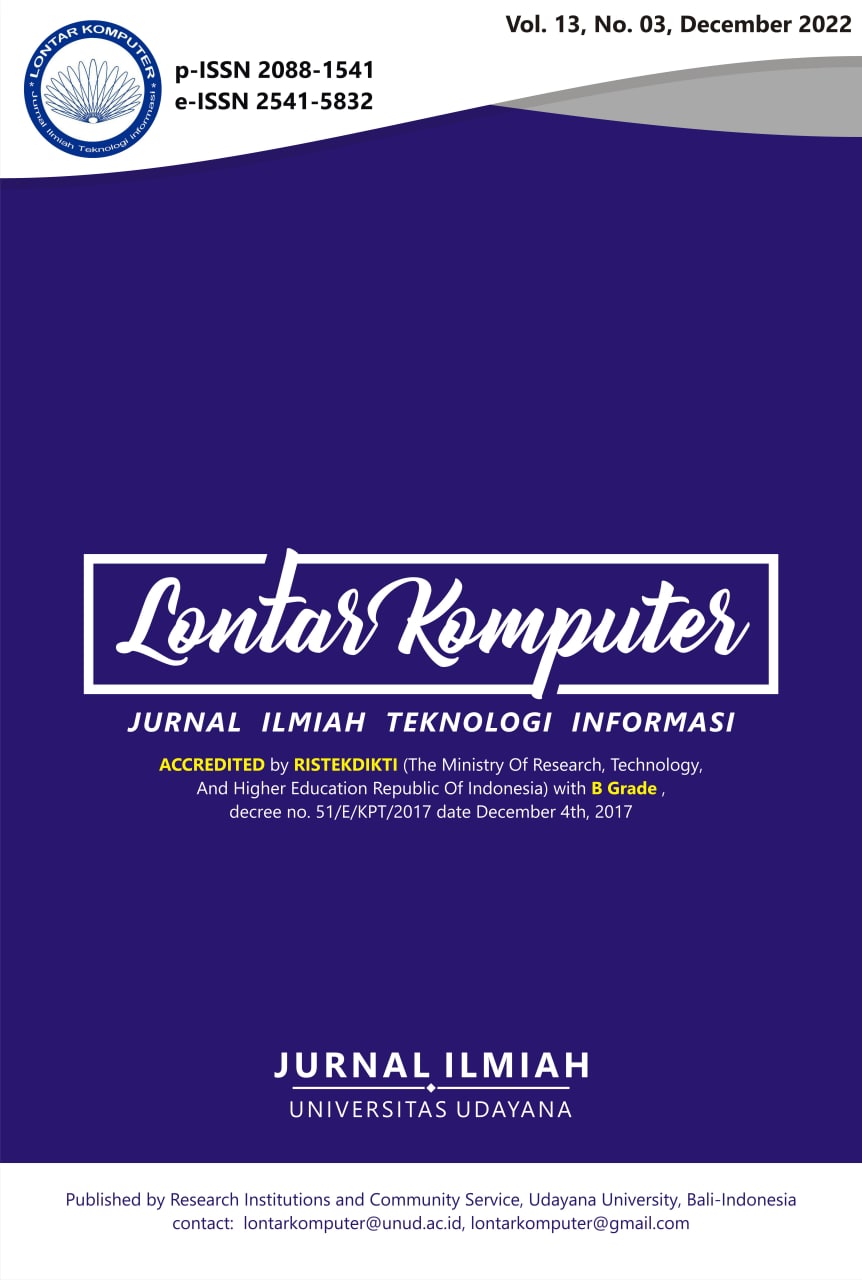Sentiment Analysis on Product Reviews from Shopee Marketplace using the Naïve Bayes Classifier
Abstract
Online shopping has become a popular shopping method ever since the number of internet users increased. Online shopping activities have become very easy and flexible because they can be completed anywhere and anytime. The products provided are also complete. The products sold often do not always match the actual conditions because the product can only be seen through pictures. Users who have purchased a product can share their opinions using the review feature. However, the products purchased thousands or millions of times have many reviews. To take an overview of the product, it is essential to go through every positive and negative review, which takes a lot of time and effort. Reviews of products from the Shopee marketplace will be classified into positive or negative sentiments towards women's home wear clothing or house dress in this study. The research starts with data crawling, text preprocessing, training data, testing, and evaluation model and then concludes with a general description based on the most frequently discussed topics in the reviews for each sentiment class. Classification is done using the Naïve Bayes Classifier algorithm. The accuracy obtained is 90,03%. The total dataset is 2907 data.
Downloads
References
[2] N. Vasic, M. Kilibarda, and T. Kaurin, "The Influence of Online Shopping Determinants on Customer Satisfaction in the Serbian Market," International Journal of Creative Research Thoughts, vol. 14, no. 2, pp. 0–0, 2019, doi: 10.4067/s0718-18762019000200107.
[3] S. R. Reddy. V., D. V. L. N. Somayajulu, and A. R. Dani, "Classification of Movie Reviews Using Complemented Naive Bayesian Classifier," International Journal of Intelligent Computing Research, vol. 2, no. 3, pp. 148–153, 2011, doi: 10.20533/ijicr.2042.4655.2011.0019.
[4] R. A. Rangsang and H. Millayani, "The Effect Of Online Consumer Review On Customer Purchase Decision Process In The E-commerce Site Blibli. com," e-Proceeding of Management, vol. 8, no. 6, pp. 8501–8513, 2021, [Online]. Available: https://openlibrarypublications.telkomuniversity.ac.id/index.php/management/article/view/17071.
[5] M. Rezki, D. N. Kholifah, M. Faisal, P. Priyono, and R. Suryadithia, "Analisis Review Pengguna Google Meet dan Zoom Cloud Meeting Menggunakan Algoritma Naïve Bayes," Jurnal Infortech, vol. 2, no. 2, pp. 264–270, 2020, doi: 10.31294/infortech.v2i2.9286.
[6] A. K. Janah, E. D. Wahyuni2, and A. A. Arifiyanti, “Klasifikasi Emosi Ulasan Aplikasi Traveloka,” Jurnal Informatika dan Sistem Informasi (JIFoSI), vol. 1, no. 3, pp. 716–722, 2020.
[7] D. A. Muthia, “Analisis Sentimen Pada Review Restoran Dengan Teks Bahasa Indonesia Mengunakan Algoritma Naive Bayes,” Jurnal ilmu Pengetahuan Dan Teknologi Komputer, vol. 2, no. 2, pp. 39–45, 2017.
[8] A. Febriyanti, “Analisis Sentimen Persepsi Pengguna Jne Menggunakan Algoritma Naïve Bayes Classifier,” no. 16522259, 2018.
[9] S. Ailiyya, “Analisis Sentimen Berbasis Aspek Pada Ulasan Aplikasi Tokopedia Menggunakan Support Vector Machine,” vol. 3, no. 2017, pp. 54–67, 2020, [Online]. Available: http://repositorio.unan.edu.ni/2986/1/5624.pdf.
[10] A. D. Adhi Putra, “Analisis Sentimen pada Ulasan pengguna Aplikasi Bibit Dan Bareksa dengan Algoritma KNN,” JATISI (Jurnal Teknik Informatika dan Sistem Informasi), vol. 8, no. 2, pp. 636–646, 2021, doi: 10.35957/jatisi.v8i2.962.
[11] A. Paputungan, Casey; Jacobus, “Sentiment Analysis of Social Media Users Using Long-Short Term Memory Method,” Jurnal Teknik Elektro dan Komputer vol.10, vol. 10, no. 2, pp. 99–106, 2021.
[12] C. Fadlan, S. Ningsih, and A. P. Windarto, “Penerapan Metode Naïve Bayes Dalam Klasifikasi Kelayakan Keluarga Penerima Beras Rastra,” Jurnal Teknik Informatika Musirawas (JUTIM), vol. 3, no. 1, p. 1, 2018, doi: 10.32767/jutim.v3i1.286.
[13] A. T. Hardianti, A. R. Manga, and H. Darwis, “Penerapan metode Naive Bayes pada klasifikasi judul jurnal,” Prosiding Seminar Nasional Ilmu Komputer dan Teknologi Informasi, vol. 3, no. 2, p. 97, 2018, [Online]. Available: http://e-journals.unmul.ac.id/index.php/SAKTI/article/view/1838/pdf.
[14] S. Juniarsih, E. F. Ripanti, and E. E. Pratama, “Implementasi Naive Bayes Classifier pada Opinion Mining Berdasarkan Tweets Masyarakat Terkait Kinerja Presiden dalam Aspek Ekonomi,” Jurnal Sistem dan Teknologi Informasi (Justin), vol. 8, no. 3, p. 239, 2020, doi: 10.26418/justin.v8i3.39118.
[15] L. Dennis, F. Ramdhana, T. C. E. Faustine, and R. B. Hendijani, "Influence of Online Reviews and Ratings on the Purchase Intentions of Gen Y Consumers: the Case of Tokopedia," International Journal of Management (IJM), vol. 11, no. 6, pp. 26–40, 2020, doi: 10.34218/IJM.11.6.2020.003.
[16] L. Shanty Wato Wele Keaan, “Analisis Sentimen Review Shopee Berbahasa Indonesia Menggunakan Improved K-Nearest Neighbor dan Jaro Winkler Distance,” Jurnal Pengembangan Teknologi Informasi dan Ilmu Komputer, vol. 3, no. 7, pp. 2548–964, 2019, [Online]. Available: http://j-ptiik.ub.ac.id.
[17] K. A. Rokhman, B. Berlilana, and P. Arsi, “Perbandingan Metode Support Vector Machine Dan Decision Tree Untuk Analisis Sentimen Review Komentar Pada Aplikasi Transportasi Online,” Journal of Information System Management (JOISM), vol. 3, no. 1, pp. 1–7, 2021, doi: 10.24076/joism.2021v3i1.341.

This work is licensed under a Creative Commons Attribution 4.0 International License.
The Authors submitting a manuscript do so on the understanding that if accepted for publication, the copyright of the article shall be assigned to Jurnal Lontar Komputer as the publisher of the journal. Copyright encompasses exclusive rights to reproduce and deliver the article in all forms and media, as well as translations. The reproduction of any part of this journal (printed or online) will be allowed only with written permission from Jurnal Lontar Komputer. The Editorial Board of Jurnal Lontar Komputer makes every effort to ensure that no wrong or misleading data, opinions, or statements be published in the journal.
 This work is licensed under a Creative Commons Attribution 4.0 International License.
This work is licensed under a Creative Commons Attribution 4.0 International License.























